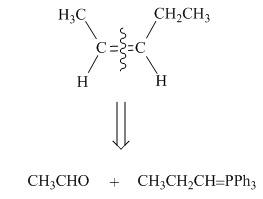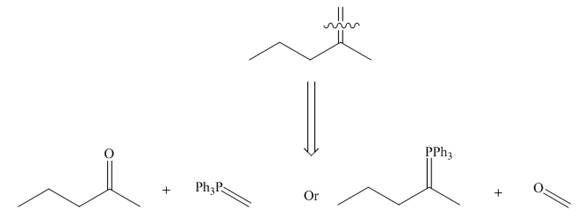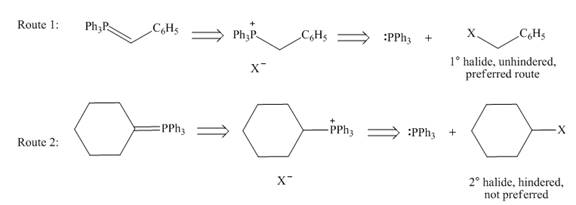
Concept explainers
What Wittig reagent and carbonyl compound are needed to prepare each
a.
 c.
c. ![]() d.
d. 
(a)
Interpretation: The Wittig reagent and carbonyl compound that are needed to prepare the given alkene are to be predicted, and the preferred route is to be identified, if any.
Concept introduction: One should follow the two steps retro synthesis to find out the starting materials that are needed to prepare the given alkene. The first step is cleaving of
Answer to Problem 21.57P
The Wittig reagent and carbonyl compound that are needed to prepare the given alkene are
Explanation of Solution
One should follow the two steps retrosynthesis to find out the Wittig reagent and carbonyl compound that are needed to prepare the given alkene. The first step is cleaving of

Figure 1
The second step is selection of preferred pathway. The Wittig reaction involves two pathways to synthesize unsymmetrical alkene and only one pathway to synthesize symmetrical alkene.
While selection one should consider that pathway in which Wittig reagent is derived from an unhindered alkyl halide, like

Figure 2
The first step for the preparation of Wittig reagent, formation of phosphonium salts, takes place through the
Thus, the Wittig reagent and carbonyl compound that are needed to prepare the given alkene are
The Wittig reagent and carbonyl compound that are needed to prepare the given alkene are
(b)
Interpretation: The Wittig reagent and carbonyl compound that are needed to prepare the given alkene are to be predicted, and the preferred route is to be identified, if any.
Concept introduction: One should follow the two steps retro synthesis to find out the starting materials that are needed to prepare the given alkene. The first step is cleaving of
Answer to Problem 21.57P
The Wittig reagent and carbonyl compound that are needed to prepare the given alkene are
Explanation of Solution
One should follow the two steps retrosynthesis to find out the Wittig reagent and carbonyl compound that are needed to prepare the given alkene. The first step is cleaving of

Figure 3
The second step is selection of preferred pathway. The Wittig reaction involves two pathways to synthesize unsymmetrical alkene and only one pathway to synthesize symmetrical alkene.
While selection one should consider that pathway in which Wittig reagent is derived from an unhindered alkyl halide, like

Figure 4
The first step for the preparation of Wittig reagent, formation of phosphonium salts, takes place through the
Thus, the Wittig reagent and carbonyl compound that are needed to prepare the given alkene are
The Wittig reagent and carbonyl compound that are needed to prepare the given alkene are
(c)
Interpretation: The Wittig reagent and carbonyl compound that are needed to prepare the given alkene are to be predicted, and the preferred route is to be identified, if any.
Concept introduction: One should follow the two steps retrosynthesis to find out the starting materials that are needed to prepare the given alkene. The first step is cleaving of
Answer to Problem 21.57P
The Wittig reagent and carbonyl compound that are needed to prepare the given alkene are shown in Figure 6. The preferred pathway is Route 1.
Explanation of Solution
One should follow the two steps retrosynthesis to find out the Wittig reagent and carbonyl compound that are needed to prepare the given alkene. The first step is cleaving of
 Figure 5
Figure 5
The second step is selection of preferred pathway. The Wittig reaction involves two pathways to synthesize unsymmetrical alkene and only one pathway to synthesize symmetrical alkene.
While selection one should consider that pathway in which Wittig reagent is derived from an unhindered alkyl halide, like

Figure 6
The first step for the preparation of Wittig reagent, formation of phosphonium salts, takes place through the
Thus, the Wittig reagent and carbonyl compound that are needed to prepare the given alkene are,

Figure 7
The Wittig reagent and carbonyl compound that are needed to prepare the given alkene are shown in Figure 6. The preferred pathway is Route 1.
(d)
Interpretation: The Wittig reagent and carbonyl compound that are needed to prepare the given alkene are to be predicted, and the preferred route is to be identified, if any.
Concept introduction: One should follow the two steps retrosynthesis to find out the starting materials that are needed to prepare the given alkene. The first step is cleaving of
Answer to Problem 21.57P
The Wittig reagent and carbonyl compound that are needed to prepare the given alkene are shown in Figure 7. The preferred pathway is Route 1.
Explanation of Solution
One should follow the two steps retrosynthesis to find out the Wittig reagent and carbonyl compound that are needed to prepare the given alkene. The first step is cleaving of
 Figure 8
Figure 8
The second step is selection of preferred pathway. The Wittig reaction involves two pathways to synthesize unsymmetrical alkene and only one pathway to synthesize symmetrical alkene.
While selection one should consider that pathway in which Wittig reagent is derived from an unhindered alkyl halide, like

Figure 9
The first step for the preparation of Wittig reagent, formation of phosphonium salts, takes place through the
Thus, the Wittig reagent and carbonyl compound that are needed to prepare the given alkene are,

Figure 10
The Wittig reagent and carbonyl compound that are needed to prepare the given alkene are shown in Figure 10. The preferred pathway is Route 1.
Want to see more full solutions like this?
Chapter 21 Solutions
ALEKS 360 CHEMISTRY ACCESS
- What product is formed when acetic acid is treated with each reagent: (a) CH3NH2; (b) CH3NH2, then heat; (c) CH3NH2 + DCC?arrow_forwardWhat Wittig reagent and carbonyl compound are needed to prepare each alkene? When two routes are possible, indicate which route, if any, is preferred.arrow_forwardDevise a synthesis of each alkene using a Wittig reaction to form the double bond. You may use benzene and organic alcohols having four or fewer carbons as starting materials and any required reagents.arrow_forward
- Draw the products formed when phenol(C6H5OH) is treated with each reagent. Give an explanation. a. HNO3, H2SO4 h. product in (a), then Sn, HClarrow_forwardwhich reagents complete the reaction?arrow_forward(a) Give an acceptable name for each compound, (b) Draw the organic products formed when A or B is treated with each reagent: [1] H3O+; [2] −OH, H2O; [3] CH3CH2CH2MgBr (excess), then H2O; [4] LiAlH4, then H2O.arrow_forward
 ChemistryChemistryISBN:9781305957404Author:Steven S. Zumdahl, Susan A. Zumdahl, Donald J. DeCostePublisher:Cengage Learning
ChemistryChemistryISBN:9781305957404Author:Steven S. Zumdahl, Susan A. Zumdahl, Donald J. DeCostePublisher:Cengage Learning ChemistryChemistryISBN:9781259911156Author:Raymond Chang Dr., Jason Overby ProfessorPublisher:McGraw-Hill Education
ChemistryChemistryISBN:9781259911156Author:Raymond Chang Dr., Jason Overby ProfessorPublisher:McGraw-Hill Education Principles of Instrumental AnalysisChemistryISBN:9781305577213Author:Douglas A. Skoog, F. James Holler, Stanley R. CrouchPublisher:Cengage Learning
Principles of Instrumental AnalysisChemistryISBN:9781305577213Author:Douglas A. Skoog, F. James Holler, Stanley R. CrouchPublisher:Cengage Learning Organic ChemistryChemistryISBN:9780078021558Author:Janice Gorzynski Smith Dr.Publisher:McGraw-Hill Education
Organic ChemistryChemistryISBN:9780078021558Author:Janice Gorzynski Smith Dr.Publisher:McGraw-Hill Education Chemistry: Principles and ReactionsChemistryISBN:9781305079373Author:William L. Masterton, Cecile N. HurleyPublisher:Cengage Learning
Chemistry: Principles and ReactionsChemistryISBN:9781305079373Author:William L. Masterton, Cecile N. HurleyPublisher:Cengage Learning Elementary Principles of Chemical Processes, Bind...ChemistryISBN:9781118431221Author:Richard M. Felder, Ronald W. Rousseau, Lisa G. BullardPublisher:WILEY
Elementary Principles of Chemical Processes, Bind...ChemistryISBN:9781118431221Author:Richard M. Felder, Ronald W. Rousseau, Lisa G. BullardPublisher:WILEY





